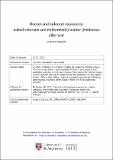Decent and indecent exposures : naked veterans and militarized (counter-)violences after war
Abstract
This article analyzes the multiple and contradictory functions of barracks nostalgia for a veterans’ organization in the United States (US), Irreverent Warriors, and for its principal activity, Silkies Hikes. These are day-long events across the US in which military veterans, both men and women, convene to hike in their underwear to prevent veteran suicide. The Hikes are more than exhibitionistic gatherings of nearly naked veterans; they are elaborate rituals where veterans expose and deploy their bodies to navigate and survive return from war. Drawing on feminist and queer theoretical insights, I develop a reparative case study of the Hikes to explore three arguments. First, militarized nudity can be more than, and other than, violation. Second, nurturing militarized masculinity might be experienced as necessary for some veterans’ post-war adjustment. Third, nostalgic re-enactments are not either re-militarizing or de-militarizing; rather, Silkies Hikers are militarized subjects undergoing a de-militarization process that they experience as violent and traumatic, so they in turn seek out, or even demand, re-militarization – but re-militarization re-cast as a counter-violent maneuver. Consequently, Silkies Hikes represent a critical opportunity to elaborate theories of militarized masculinity and foreground dilemmas involved in calling on endangered bodies to do the work of de-militarization.
Citation
McMullin , J R 2021 , ' Decent and indecent exposures : naked veterans and militarized (counter-)violences after war ' , International Feminist Journal of Politics , vol. 23 , no. 1 , pp. 27-57 . https://doi.org/10.1080/14616742.2020.1861548
Publication
International Feminist Journal of Politics
Status
Peer reviewed
ISSN
1461-6742Type
Journal article
Description
Funding: This work was supported by the Carnegie Trust for the Universities of Scotland [grant number: Research Incentive Grant / #70061].Collections
Items in the St Andrews Research Repository are protected by copyright, with all rights reserved, unless otherwise indicated.

